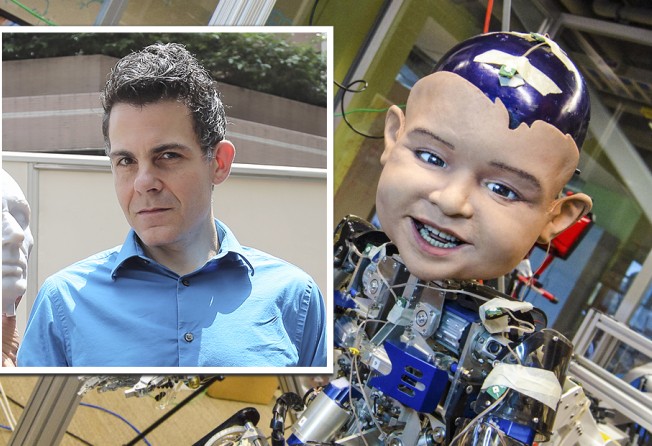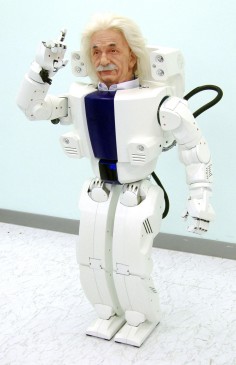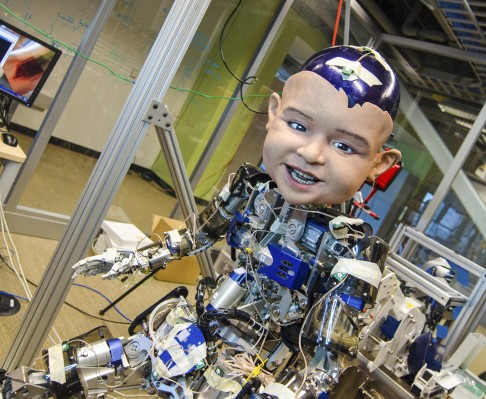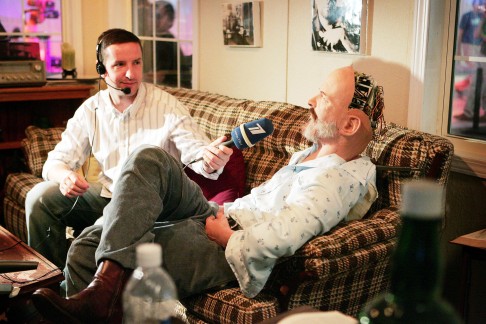Robot expert planning to turn Hong Kong into android city
US robotics designer David Hanson has his sights set on turning Hong Kong into a hub of android activity, writes Bernice Chan

Walking into David Hanson's office in Sheung Wan, a human-looking robot with a cascade of wires sprouting from the back of its head catches your attention. Its eyes are looking in two different directions, but it is moving its jaw and raising its eyebrows, apparently aping the technician working on the wiring. It's fascinating, if somewhat disconcerting, to watch a machine being manipulated into behaving like a real person.
Hanson, 44, is an American robotics designer known for creating lifelike humanoid machines. The founder and president of Hanson Robotics, he sees robotics as his calling and works on many fronts, from sculpting features to developing artificial intelligence.
To advance to the next step of producing robots for everyday applications in entertainment, health care and education, he has moved to Hong Kong with his family - his wife Amanda and their son Zeno.
Hong Kong seems a curious move for Hanson, but he and Korean-American entrepreneur Jong Lee, Hanson Robotics CEO, say a robotics community is emerging here.

He hopes to help establish a robotics hub and, as part of his talk at TEDx Hong Kong on May 31, will encourage related enterprises to move into the Science Park in Sha Tin.
At Hanson Robotics, the team believes the immediate future for the business lies in creating animatronic robots for theme parks while it develops for the longer term lifelike androids to work in hospitals and with special needs children.
"Autistic kids often have to learn through brute memorisation," Lee says. "The robot can be trained to respond to reactions, repeating things over and over."
There is growing interest in using social robots to help autistic children because they can be programmed to help youngsters practice making eye contact, wait for their turn to play and do other exercises that improve their social and cognitive skills.
NAO, which was developed by Paris-based Aldebaran Robotics, is one example.
And because robots can function around the clock, they can also make tireless nursing assistants. If armed with facial recognition software, Lee says, these robots will be able to greet patients by name and ask questions about their heart rate and other vital signs. What's more, they won't mess up the medication.
"When you have robots helping nurses, they [the nurses] are 30 per cent more productive," he says, noting that there will be greater need for nurses as the population ages.
Although robotics engineer Masahiro Mori once argued that people would be repulsed by human-looking robots, Hanson's experience has been different, and he is out prove the Japanese expert wrong.
Besides, Lee says: "Robots are not as foreign as they were 20 years ago; they can be very human."

Still, he continued to develop his artistic skills; he graduated from the Rhode Island School of Design and got a job at Walt Disney Imagineering, where he helped create animatronic robots for Disney theme parks. He also worked at California's Jet Propulsion Laboratory, which works on robotics for US space agency Nasa.
After developing his first robot in 2002, he gained attention three years later when he created an "intelligent conversational portrait" of Philip K. Dick, the sci-fi writer of classics such as Do Androids Dream of Electric Sheep?
Dick died in 1982 but Hanson was able to resurrect the author as a talking head. This could "converse" about his work, after having been fed thousands of pages of his writing.
A lifelike head of Albert Einstein soon followed, which he placed on top of a Korean-made robot body. It could walk around a room and move its arms and hands.
Hanson's latest project is The Dmitry, a commission from Russian media mogul Dmitry Itskov, who seeks to achieve "immortality" by transferring his consciousness to an avatar, or a robot in his likeness.
It is part of Itskov's 2045 Initiative, which aims to enable individuals to upload digital copies of their minds to a non-biological carrier by 2045.

"They will be either extremely useful, or turn into feral children who we will find scary, and who won't value us, and who will act unpredictably. We need to raise them like our friends," he says.
Among his collaborators in this area is Ben Goertzel, a co-founder of Hong Kong stock prediction start-up Aidyia. Goertzel has also been working on AGI - the kind of machine learning that would enable a robot to "think" more like a person.
"Right now we have robots that can talk but don't know what they are saying," he says.
For example, a robot greeter in a Walmart could be programmed to tell you which aisle to go to for a particular product. But if you ask for a gadget that helps you take the wheel off a car, it would not know that a wrench is required.
Goertzel believes AGI can advance to a more sophisticated level in a matter of years, rather than decades.
Competition is fierce, especially in technology. Even so, Hanson is keen to develop AGI systems on an open-source platform, where participants share information about what they have learnt so that the process can be speeded up.
"Intelligence systems are extremely complex, and cannot be done in one lab. You need to have a big science approach, like the international space station, where there are open standards and interfaces so that we can work together," he says.
"Artificial minds are the most ambitious undertaking in history. It's the science and engineering of minds. You need governments, companies and researchers participating. No one [organisation] can make it - you need to have thousands co-operating, and open source methods can help.
"Creativity is at the heart of this undertaking; when you have tonnes of pieces created by thousands of people working concurrently. No company could afford that," he says.
Meanwhile, Lee is seeking support from InvestHK and angel investors, as well as applying research grants to fund Hanson Robotics' relocation and expansion in Hong Kong.
It is a strategic decision for Hanson Robotics to base itself in Hong Kong, even as he aims to raise US$15 million globally.
While Silicon Valley is the Mecca for many hi-tech ventures, Lee says the place is too software-oriented. Robotics requires greater artistic and hardware input.
"For the next few years, entertainment [growth] is in Asia and customers like to be close to their suppliers," Lee says.
Hong Kong has an edge, because its toy industry has decades of manufacturing experience. This will help them get robots to the market more quickly, and at more affordable prices.
"The expertise and design infrastructure here is useful for us, because they are used to getting high-quality toys made at a lower cost," Lee says.
He cites drones as an example. These can cost several thousand dollars, but toy designers in Asia have been able to adapt the design and components, to produce HK$80 remote-controlled helicopters for children.
Hanson Robotics hope to produce robots more cheaply, and therefore cultivate a market.
Goertzel suggests they could learn from Mark Tilden, who created Robosapien, a 14-inch toy robot, for less than US$100 using components made across the border. "The ones that sway their hips like a woman are very popular in Japan," he says with a laugh.
Hanson Robotics aims to make human-sized robots that would sell between US$30,000 and US$250,000. The idea is to have parts made on the mainland, with assembly taking place in Hong Kong.
These robots could be leased by companies or groups of families, who might share a robot to train their autistic children, and Lee believes they will get their return on investment within a year.
"The US has created human-sized military robots at US$5 million each," says Goertzel. "What about creating robots at a lower cost that will have a greater impact on society?"
Like Lee, he believes Hong Kong is uniquely positioned to produce affordable robots thanks to its proximity to a manufacturing base in Guangdong. High property costs and a shortage of robotics engineers are hurdles, but he believes that latter can be solved by looking across the border.
That's why Goertzel believes we are just years away from having a robot [read] the news. "Once we have sufficient demonstrations of what robots and AGI can do, this will be the Sputnik of AI. This is the next big thing," he says.
However, experts such as Matthias Scheutz, a professor of computer science at Tufts University in Massachusetts, take a more measured view.
While acknowledging that robot technology is advancing quickly, Scheutz says we are a long way from producing robots that resemble humans. The general goal isn't to replace real people, except in situations where lives are at risk, such as rescue missions in disaster areas, or exploratory missions in outer space, he says.
But AGI isn't about to be achieved any time soon.
"That's a pipe dream of people in the AGI community," says Scheutz.